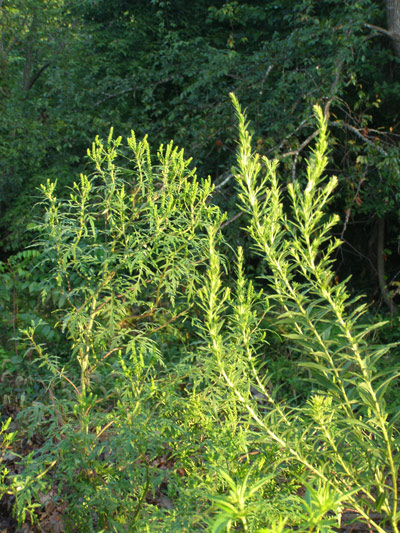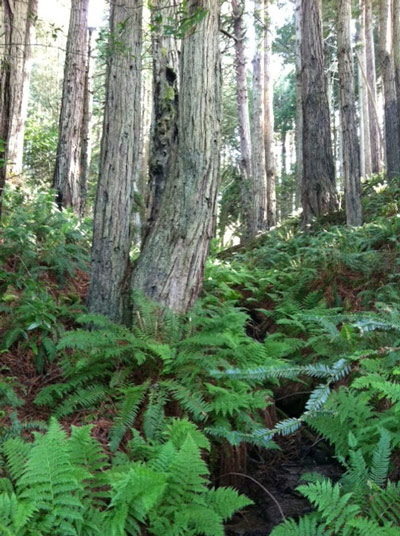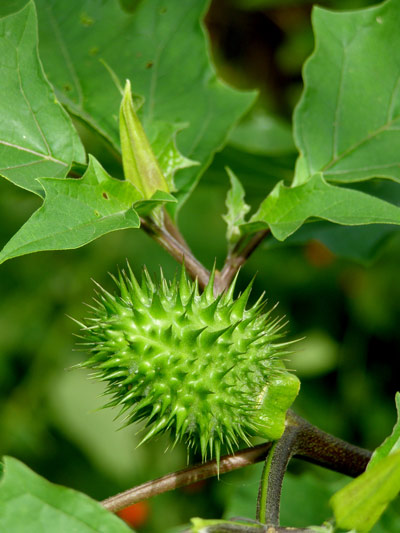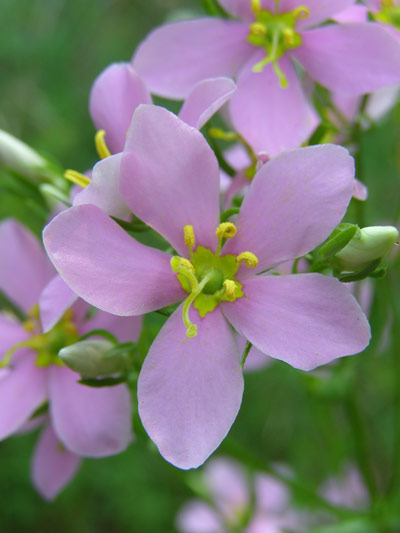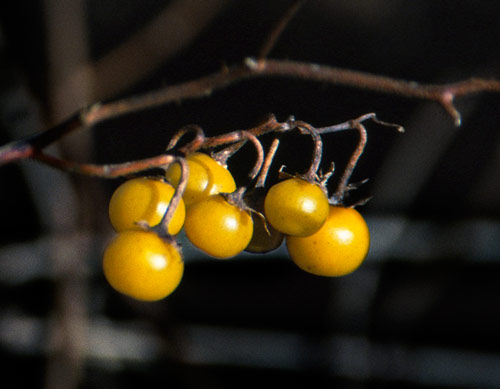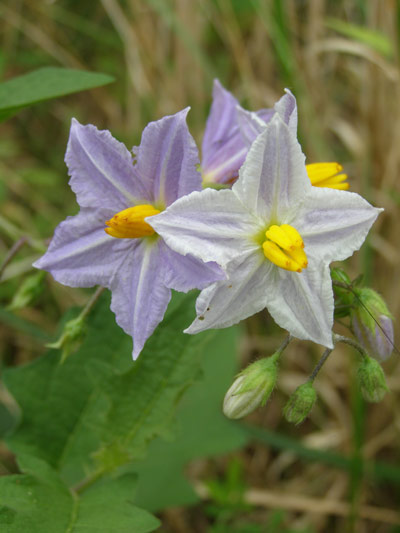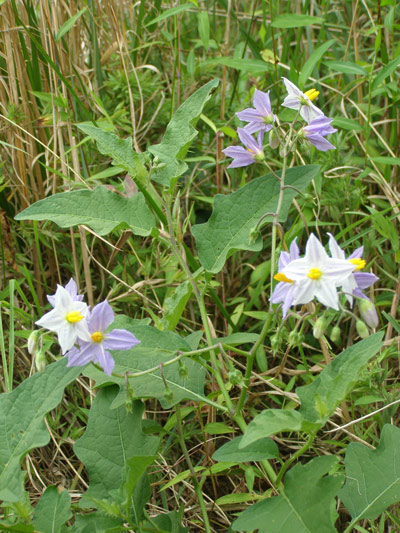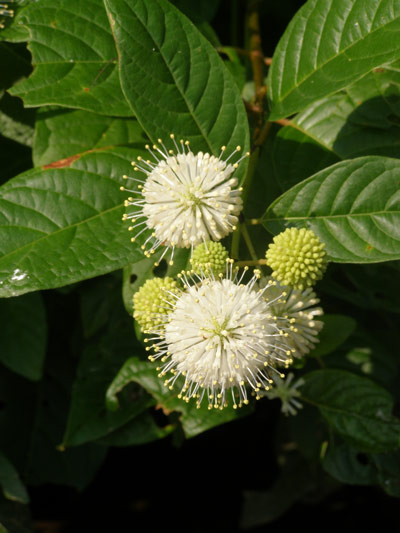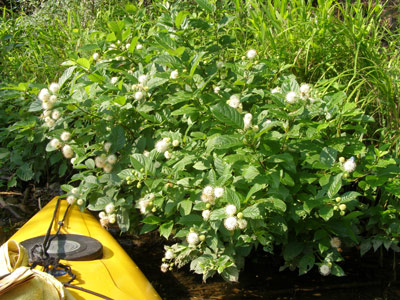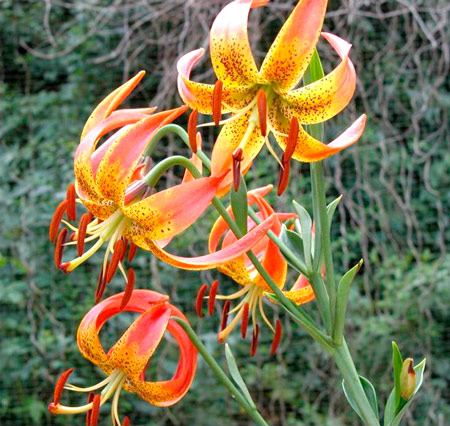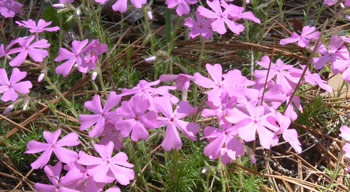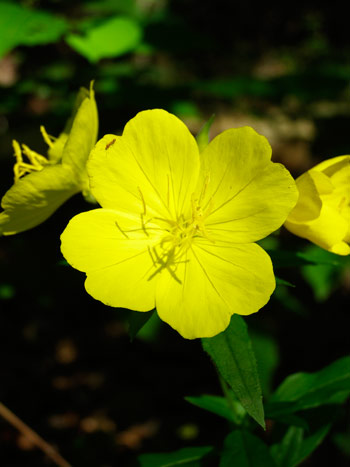By Ken Moore
Flora Columnist

Beautiful goldenrods, which don’t cause hay fever, will brighten our roadsides through the fall. Photo by Ken Moore
Please don’t blame hay-fever sneezes and stuffy noses on beautiful goldenrod.
But before I go into that, there’s more about Chapel Hill’s mystery tree.
Last week, space did not allow for me to tell how John Eliadis’ dad also remembered there was a covenant issued that Chapel Hill’s coastal redwood could never be cut. Obviously Duke Energy’s utility pruning crew didn’t know about that covenant when they performed their recent drastic pruning job on that tree.
But Chapel Hill town forester Curtis Brooks, once a Coker Arboretum curator who credits W.C. Coker with planting that tree, is not familiar with such a town covenant.
So emerges another mystery: What is, or was, that “no tree-cutting covenant?†Hopefully someone in Chapel Hill government or a town historian will uncover the answer.
Now back to hay-fever season. In spite of garden columns and articles in horticulture magazines during past decades, many of us still blame the fall season’s miseries on strikingly visible goldenrods.
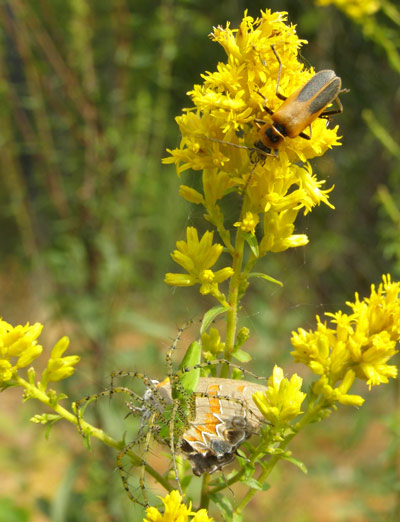
A closer look reveals a soldier beetle at top, unaware of the drama below, where a lynx spider has captured a hairstreak butterfly. Photo by Ken Moore
For goldenrod pollen to get up your nose, a bee or butterfly or other pollinating insect will have to carry it there, so you may relax when you see or walk by goldenrods. Goldenrods were one of the first American plants carried back in the mid-1600s to English gardens, where they are still a perennial favorite in flower borders.
Here we enjoy a long flowering season from more than 50 species of Solidago. Herbal fragrant goldenrod, Solidago odora, came into flower on Occoneechee Mountain in early July, and several other goldenrods have colored the roadsides since. Now the early tall goldenrod, Solidago gigantea, is beginning to bloom out at Mason Farm and along sunny roadsides. Late tall goldenrod, Solidago altissima, will continue the season into November.
Ragweed, as the photo shows, often grows right next to goldenrod. Ragweed leaf margins are distinctly deeply lobed like marigold leaves and in contrast, goldenrod leaves have smooth (entire) or finely toothed margins.
Ragweed flowers, without showy petals, are difficult to discern. They appear as a little candelabra of erect stems of countless pollen-bearing anther sacs held high above non-petaled female flowers in leaf axils on stems below. When fully mature the erect male candelabras are yellow with exposed pollen, waiting for the slightest breeze. These flowers are virtually unseen next to showy golden-yellow flower heads of goldenrods.
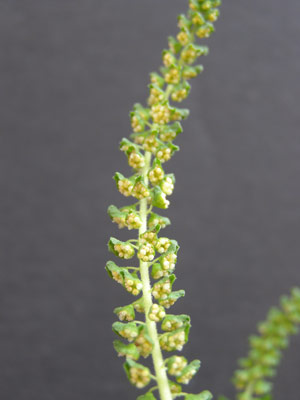
Hidden beneath green bracts, ragweed male flower pollen sacs here are about to explode, releasing clouds of pollen into the air. Photo by Ken Moore
When we sneeze and see goldenrods in flower, it’s easy to cast blame on the innocent, but that’s circumstantial evidence at best.
Learn the difference, avoid the ragweeds and take a closer look at the goldenrods, where you’re likely to find interesting pollinators and tiny spiders hidden amongst the flowers awaiting their unsuspecting dinner visitors.
Email Ken Moore at flora@carrborocitizen.com. Find previous Ken Moore Citizen columns at The Annotated Flora.
By Ken Moore
Flora Columnist
Several years ago I received a call from Bill Massengale, who was keen about the history of the California coastal redwood, Sequoia sempervirens, standing tall in front of his law office on North Columbia Street, just above the Chapel Hill fire station. Old-timers used to call that entrance to town “Fire House Hill†because the fire department was originally located in what is now the homeless shelter.
In search of an answer to Bill’s inquiry about who planted that tree and when, I queried botany professors, town officials and community old-timers; no one knew. That was several years ago.
This past spring I saw coastal redwoods growing in the wild where America’s tallest growing tree survives in fog-laden ravines and canyons along the California coast. That memorable experience made me reflect again on Chapel Hill’s redwood mystery.
I know for certain that Dr. Cliff Parks of the UNC botany department began rooting cuttings of the branch tips of that tree back in the late 1970s. One of Dr. Parks’ successful cuttings is now a beautiful 30-year-old specimen growing in the Coker Arboretum. Another is at the corner of the Stephens Street parking entrance to Chapel Hill Town Hall.
Cliff’s son David Parks of Camellia Forest Nursery has also rooted cuttings of that tree and, though success is minimal, over the years father and son have produced enough rooted cuttings that numerous young specimens are now growing in local gardens under Dr. Parks’ cultivar name, Sequoia sempervirens, “Chapel Hill.â€
How amazing it is that coastal redwoods from the foggy Pacific coast will survive in our Piedmont climate. David has other cultivars of the coastal redwood at Camellia Forest Nursery, and I plan to procure and plant one of my own later this fall.
But still, who planted that original Chapel Hill tree?
A few weeks ago I learned from Bob Durham of Academy Opticians that when he was a kid, he lived next door to that tree for several years, and he remembers it was a big tree several decades ago. Bob referred me to his childhood friend John Eliadis, whose dad owned and managed legendary Leo’s on West Franklin Street. John, now living in Carrboro, also remembers that tree and recalls his dad describing how UNC chemistry professor Dr. Francis Preston Venable, president of the university from 1900-1914, brought seedlings of coastal redwood back from California in the early 1900s to establish in Chapel Hill and other locations on the East Coast.
For more clues in this tree mystery I turned to Bill Burk, local historian and retired botany librarian. He reminded me that in 1900 President Venable convinced newly appointed botany professor Dr. W.C. Coker to develop an arboretum in the 5-acre wet meadow next to the present Morehead Planetarium.
Bill directed me to a photograph in Essays on William Chambers Coker, Passionate Botanist, by Coker’s niece Mary Coker Joslin, of Coker standing beneath a redwood during a visit to California in 1909. So it seems logical that passionate botanist Coker was the one who brought redwoods back from California. But no one seems to know for certain.
I have a theory based on a couple of facts.
Coker, who married Venable’s eldest daughter, Louise, and Venable were close family friends as well as revered academic colleagues.
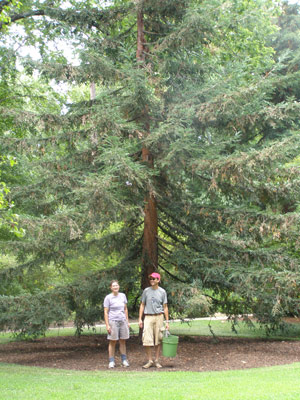
Coker Arboretum curator Margo McIntyre (left) and assistant Geoffrey Neal are dwarfed by the 30-year-old "Chapel Hill" coastal redwood. Photo by Ken Moore
Opposite the coastal redwood on North Columbia Street is a specimen of long leaf pine, Pinus palustris, the iconic conifer of the Southeast, similarly reduced to less than 5 percent of its original range, like the iconic coastal redwood of California.
My theory: Close friends Coker and Venable planted those two trees around 1910 purposefully to frame the northern entrance to the town and university with two stately evergreen conifers, each representing the continent’s west and east coasts.
Think about it, and for goodness sake, someone out there among you, let us know the real story about Chapel Hill’s mystery tree.
Please take care not to confuse coastal redwood with the less common California giant sequoia, Sequoiadendron giganteum. That’s another story in itself.
Email Ken Moore at flora@carrborocitizen.com. Find previous Ken Moore Citizen columns at The Annotated Flora.
By Ken Moore
Flora Columnist
I had all but given up on the reappearance of my very favorite annual wildflower, jimsonweed, which usually appears in the yard and garden by early June. Only in the last couple of weeks has it shown up, and I’m so elated that I’m falling back to repeat what I wrote about it this time last summer.
Jimsonweeds will volunteer wherever there is open ground. They generally don’t show up until early in the summer, and this year, in spite of the heat and the drought, I’m observing seedlings emerging late in the season. I’ve learned to recognize baby jimsonweeds because I want to have at least a few scattered about the garden. Nothing else looks quite like juvenile jimsonweed’s distinctive narrow triangular leaves with scalloped margins.
Poisonous, night-flowering jimsonweed, Datura stramonium, is a native annual, never seen in cultivated gardens. Close-relative garden varieties of Datura, also called thorn apple, and Brugmansia, angel trumpets, are frequently seen in gardens these days. They are all beautiful, and we need to be aware they are all poisonous. Flowers of cultivated thorn apple are upright trumpet-shaped flowers 6 or more inches long. The even larger cream and peach-colored flowers of angel trumpets hang down beneath the leaves.
The native jimsonweed has a smaller flower, only 3 to 4 inches long, angled upward in the axils of sturdy branches on a 3- to 6-foot-tall plant. It seems more a small shrub than a tall annual. Each ghostly white, trumpet-shaped flower bears an intriguing purple center. It opens in the early evening to be pollinated by night-flying insects searching for pale-colored glow-in-the-dark, heavily scented flowers. The flower’s mysterious musty scent is alluring, and viewing them during evening explorations is a special experience.
Though poisonous, the plant has a rich medicinal heritage. Quoting Jim Duke (Handbook of Northeastern Indian Medicinal Plants): “In Virginia, Algonquin fed male pubic initiates tea made from Datura, enough to keep them drugged for two to three weeks. Such initiates were supposed to forget everything and learn again, as men, not boys.†Apparently Capt. John Smith’s followers at Jamestown tried this native custom, resulting in lengthy nonproductive stupors. It became known as loco weed and Jamestown weed. As often happens, names change as they are handed down through the years. “Jamestown weed†became “jimsonweed.â€
I am amused with Paul Green’s recollection (Paul Green’s Plant Book): “We children used to have great fun in the dusk of warm summer evenings chasing after great tobacco moths that haunted the strong scented blooms of the jimson weed. I read in an old book once where it said that harem wives in Turkey were wont to chew this weed and swallow the juice to strengthen their powers of love. I wonder what the head of the harem, the old Turk himself, chewed.â€
Though it is a common plant throughout the state, most people miss the evening flowering and are intrigued when discovering it during winter walks when it is a curious-looking stem of bare branches with spiny egg-shaped pods. You may want to collect a few seeds and scatter them in a corner of your garden for some night flowers of your own.
Email Ken Moore at flora@carrborocitizen.com. Find previous Ken Moore Citizen columns at The Annotated Flora.
By Ken Moore
Flora Columnist
I don’t think a day goes by that I don’t reflect on Weaver Street Market staff member Teresa Hutson’s response in February to my description of visiting the ancient hollow tulip poplar still standing sentinel in the Stillhouse Bottom Natural Area and Preserve.
Following my reverential description of feeling that we humans will never live to experience as much of life as has that aged forest giant, Teresa softly responded that there’s an aged forest sentinel tree near her home that she frequently visits. And then, somewhat timidly, she described that those old monarchs of the forest “have stories to tell and if we stand quietly enough, long enough, they’ll tell us some of those stories.â€

Many trees survive lightning strikes like this one. Our fingers are crossed that Weaver Street's willow oak survives. PHOTO BY KEN MOORE
Six months later, now is an appropriate time to share Teresa’s experience and wisdom, because here in the midst of summer’s extended heat wave the Carrboro community is faced with contemplation on the town’s heritage trees.
Last week lightning struck the willow oak that dominates and shades the community’s iconic gathering place in front of Weaver Street Market.
Relatively young for such a big tree, that willow oak, most likely planted in the 1930s, grew quickly to its present stature; one does not even want to contemplate how the loss of that tree will alter the social and economic well being of the south side of Carr Mill.
The mall management has already called in professional services and the tree wounds have been treated to prevent attack from opportunistic, harmful insects during this watchful waiting period to observe how the tree responds to last week’s lightning strike. Many trees survive lightning strikes, and let’s hope this one does. Time will tell.
Back in June we learned that one of the old post oaks across from the Century Center was examined and assessed as a “hazard tree†because of considerable decay in the trunk and roots, and immediate removal was recommended. How fortunate we are that town staff decided to postpone that action and pursue additional professional assessment and input from concerned citizens.
Many factors are involved in considering how hazardous a tree with internal decay may be. For instance, it is known that some species of trees, like post oaks, stand for decades with hollow trunks, providing useful shade and necessary habitat for critters like owls, bats and flying squirrels.
In addition to the sacred hollow 200-plus-year-old Davie tulip poplar on the UNC campus, other hollow remnants of the original forest on campus continue to provide shade for students and visitors as well as protection for barred owls observed nesting in those tree cavities for several decades.
Hopefully, the Century Center post oak will be deemed strong enough to stand and provide shade for several more years.
That post oak is not alone. It is one of many 150-plus-year-old post oaks along Main, Weaver and Greensboro streets. Those oaks are remnants of the original forest, beneath the canopy of which early Carrborites built their homes on this broad hilltop we call Carrboro.

Hopefully, the Century Center post oak will be deemed strong enough to stand and provide shade for several more years. PHOTO BY KEN MOORE
Those old trees define the character of Carrboro and, as Teresa from Weaver Street Market said, “They have stories to tell.†It’s appropriate for all of us to pause quietly from time to time beneath these giants among us because, after all, “they have stories to tell.â€
Email Ken Moore at flora@carrborocitizen.com. Find previous Ken Moore Citizen columns at The Annotated Flora.
Carolina lily update and hot-pink wildflower sighting
By Ken Moore
Flora Columnist
Accompanied by a dozen Citizen readers on July 4, I revisited the Carolina lilies on Occoneechee Mountain and was disappointed they were still not in flower after seeing impressive buds two weeks earlier. The lilies seemed frozen in time on their sunny dry site.
Carolina lilies cultivated in pots at the N.C. Botanical Garden, benefiting from frequent watering, had already begun flowering. The lilies exposed up on the mountain, however, are not blessed with special attention from gardeners.
Several plants spotted on the mountain sported two robust buds and whorls of deep-green leaves, and several smaller plants bore single buds or no buds. Growing in with goldenrods and other herbs and grasses, these lilies are difficult to spot without their spectacular flower.
Those lilies are smart in not opening their flowers, beacons for pollinators, when drought and heat are not conducive to pollinator activity. Those flowers, any flowers for that matter, don’t show off for the pleasure of admiring humans. Flowering is solely targeted to attract pollinators to affect fertilization in order to produce seed for carrying on!
I visited the Occoneechee powerline lilies again this past Sunday, certain that recent welcome rains and cooler temperatures would have induced flowering activity.
But still not yet, though the buds were larger and showing a tint of color. After three weeks of watchful waiting I am now confident that if you visit the mountain powerline this next week, you’ll find Carolina lily finally in flower.
The real treat this past Sunday was stopping to take a “closer look†at rose pink, Sabatia angularis, spotted on the drive up to Hillsborough. Beautiful rose pink is in the Gentian family, though it doesn’t resemble what most of us visualize as a gentian, thanks to having to memorize William Cullen Bryant’s “To a Fringed Gentian†as a youngster.
Rose pink is neither “colored with the heaven’s own blue,†nor does it flower during the season of “frosty nights.†Pink-colored Sabatia flourishes in the dead heat of mid-summer.
Being a native biennial, it moves about and does not appear every year. It’s been a couple of years since I’ve spotted it scattered about in small patches on roadsides, woods edges and margins of wet areas.
The patch, next to a 45 mph speed-limit sign on the east side of Old N.C. 86, a short ways north of Calvander, is reasonably impressive. Take precaution to find a safe pull-off and carefully walk the narrow road edge to take a most rewarding closer look.

There are sightings of hot-pink Sabatia along Old N.C. 86 between Calvander and Hillsborough. Photo by Ken Moore
A safer place to view rose pink is in one of the fields at Mason Farm Biological Reserve. Be certain you note the difference between five-petal rose pink and four-petal meadow-beauty, Rhexia mariana, both of which are flowering there now.
Stay alert and you may spot populations of rose pink along a roadside near your home.
Email Ken Moore at flora@carrborocitizen.com. Find previous Ken Moore Citizen columns at The Annotated Flora.
By Ken Moore
Flora Columnist
The Carrboro Farmers’ Market annual Tomato Day this Saturday is a great teaching moment. When tasting those cherry tomatoes, be aware of their poisonous, look-alike horse nettle cousins.
“I’m always nervous about reading in Flora that I have yanked out another one of those wild weeds for which you have such high regard.â€
That was the response from gardening friend Diana Steele following my expressed enthusiasm in spying a horse nettle, Solanun carolinense, in her Mason Farm Road curbside garden. She timidly admitted that it was one that had escaped her weeding earlier in the day.
Diana’s forested garden is one of my favorite gardens because it is carefully tended so that it appears not untended. Knowing her garden is the discovery grounds enjoyed by the young children enrolled in Willow Hill Preschool, I offered an understanding nod, because the poisonous berries of horse nettle look like those tasty yellow-gold cherry tomatoes celebrated at the farmers’ market.
Diana is wise to keep those low-to-the-ground tomato-look-alike fruit away from the natural curiosity of children, who would be inclined to view anything looking like a cherry tomato as safe to pick and eat. We need to teach the young ones that if such fruits are found in the wild, “do not eat it!â€
Please make note that horse nettle is in the deadly nightshade family, Solanaceae, characterized by having poisonous properties. In this family also are some of our most useful plants, including potatoes, eggplant, tobacco, peppers and the revered cultivated tomato, Solanum lycopersicum. The leaves of tomatoes are poisonous to humans, but not to the deer that relish them. Tomato fruit, however, are safe, delicious and wonderfully varied as you can discover by tasting more than 70 varieties at Tomato Day.
Nature has plants both poisonous and edible, and we humans are wise to be informed.
Where young ones are not likely to get their hands on poisonous horse nettle, allow it the freedom to grow. Each time I see it in flower, I stoop down to admire those white and purplish-blue flowers, looking like tomato flowers on steroids.
Occasionally, you may stumble upon one that looks like a garden plant, like the ones seen last week in the fields of the Mason Farm Biological Reserve. Be forewarned not to touch the thorny stem.
You may remember an experience similar to that described by Paul Green (Paul Green’s Plant Book): “This pest used to play havoc with our bare feet as children, especially if the dead, dried plants chopped up by the hoe were stepped on. The thorns were sharp as little needles.â€
You definitely should tread softly when moving barefoot among horse nettles, so armored on stem and leaves. In truth, this drought-tolerant native perennial of sunny disturbed areas provides a service with its vigorous taproot breaking up barren, sterile soil, gradually improving the ground for succeeding vegetation.
There are many descriptions of medicinal uses of horse nettle, and I’ll leave that for you to investigate.
So take a closer look and admire the flowers, watch out for those spines and please don’t sample the fruit!
Email Ken Moore at flora@carrborocitizen.com. Find previous Ken Moore Citizen columns at The Annotated Flora.
By Ken Moore
Flora Columnist
After months and months, I finally got the kayak out on the water a couple weeks ago. I wanted to return to the Robeson Creek tributary of the Haw River not far above the Jordan Lake dam. I remembered launching the kayak at Robeson Creek being a bit tricky several years ago. Not so now; there’s a new canoe/kayak roll-onto-the-water floating launching dock that’s a joy to use.
I’ve set paddle from there three times during the past two weeks – twice with Tony, one of my “let’s-get-lost-in-the-woods†walking buddies, and once with my partner/spouse, Kathy.
Though each paddle was along the same shorelines, the adventures were surprisingly different.
The experiences have included impressive fish-jumping displays and spectacular bird sightings. A noisy kingfisher or two are always to be expected. The quiet-when-standing and loudly croaking-when-flying great blue herons are too numerous to count. The family of osprey screaming and fishing in proximity is awesome. And Mary Sonis’ dramatic image of the bald eagle taking flight in this month’s MILL came to mind this past Sunday when Kathy and I marveled at seeing three mature and three immature eagles at various shoreline sites during the paddle.
However, there are stretches of quiet, non-animal activity during a several-hour paddle. “Not to worry,†as the British love to say. There are so many plants hanging out along the shoreline that even casual botanizing can be engaging for hours.
Most visible along water’s edge now, while it’s in flower, is buttonbush, Cephalanthus occidentalis, literally hanging out there with its roots in the water. Buttonbush is common in wet habitats throughout the eastern half of North America and is a favored food plant for a great diversity of pollinators including painted lady, cabbage white, clouded sulphur, eastern black swallowtail and monarch butterflies.
If you have a pond, you can easily establish buttonbush along the edges. And surprisingly, you can grow buttonbush without having a wet spot. My wild-gardening buddy, Sally Heiney, was proud to describe a specimen buttonbush in the botanical garden’s Plant Families Garden that “never knew it likes to have its feet in water.†That specimen is huge – one literally stands in the shade beneath it – and Sally says it gets watered very infrequently.
There is an impressive newly planted specimen along the main entrance to the botanical garden’s Visitor Center, and nearby you’ll find buttonbush in pots at the plant sales area. Other sources of buttonbush are Cure Nursery and Mellow Marsh Farm.
Along the edges of Robeson Creek/Haw River, buttonbush will be in flower for another week or two, followed closely by the flowering of rose-mallow, Hibiscus moscheutos, another water’s-edge plant that takes well to cultivation.
A leisurely paddle reveals many interesting plants, like impressive clumps of Southern wild rice, Zizaniopsis miliacea, standing tall within extensive marshy zones of lush Asiatic dayflower, Murdannia keisak. Whether or not you can name them, you can enjoy water’s-edge botany at a distance or close-up.
Email Ken Moore at flora@carrborocitizen.com. Find previous Ken Moore Citizen columns at The Annotated Flora.
By Ken Moore
Flora Columnist
Back in 1903, Dr. W. C. Coker, UNC professor of botany, began the Coker Arboretum as an outdoor classroom to supplement classes on identification and ecology of North Carolina native plants. Over at N.C. State University, botany professor Dr. B. W. Wells was actively defining the discipline of plant ecology and described the state’s plant communities for the general public in the classic The Natural Gardens of North Carolina, published in 1932.

More than a century ago, Cornelia Phillips Spencer painted Carolina lily in context with its plant community associates, blueberry and bracken fern. Photo of painting by Ken Moore
Well before them, however, Cornelia Phillips Spencer, who continuously pestered the state legislature between 1870 and 1875 to reopen the university following its closure during the Reconstruction, was already making ecological observations about plants growing in the environs of Chapel Hill.
For more than two decades, often accompanied by her daughter, Julia, and the two Mason girls, Varina and Martha, she explored the surrounding fields and forests. On these excursions, in all seasons, she collected “ecological bouquets†of wild and cultivated flowers, some of which remain to this day as lovely colored botanical illustrations by Mrs. Spencer and her daughter.
Studying each of these beautiful illustrations, one can view details of the plant community she observed. The flower portrait above features the Carolina or Mixhaux’s lily, Lilium michauxii, painted with its ecological associates, dryland blueberry, Vaccinium pallidum, and bracken fern, Pteridium aquilinum. Cornelia Spencer most likely encountered this grouping on the high bluffs above Morgan Creek, still called Laurel Hill.
More than a century following her painting, the Carolina lily was officially designated the State Wildflower by the N.C. General Assembly in 2003. Though commonly scattered in dry upland forests throughout the state, it is seldom seen. They only attract attention when in flower for a brief week or two in mid-summer. Frequent mowing along our highways eliminates the likelihood of spotting our State Wildflower.
During my years of botanizing, I’ve only seen this native lily a few times up on Occoneechee Mountain, along with its ecological companions, dryland blueberry and bracken fern.
Early last month while viewing the mountain’s fantastic mountain laurel display, I explored the area I know to contain the lilies. I was happy to find a couple of dozen plants. When I returned last week to catch them in flower, I could not find as many. But I did find a few, most with a single flower bud and a couple with two flower buds. Though Johnny Randall has photographed one at the N.C. Botanical Garden with several flowers, I’ve never seen more than a two-flowered plant in the wild.
I’m going back to try to catch it in flower and have fingers crossed that they’re not eaten by deer or picked by enthusiastic unsupervised children inclined to pick pretty flowers.
I’m going early on the Fourth of July. You’re most welcome to join me.
Join Ken Moore on his search for the Carolina lily on Occoneechee Mountain on July 4, beginning at 8:30 a.m. from visitor’s parking area at the end of Virginia Cates Road in Hillsborough.
Email Ken Moore at flora@carrborocitizen.com. Find previous Ken Moore Citizen columns at The Annotated Flora.

A.J. Bullard, left, describing leaf characteristics of white mulberry cultivar “Pakistan†to Liam Shannon. Photo by Ken Moore
By Ken Moore
Flora Columnist
“Lived to learn it†was A.J. Bullard’s response when I queried him last week about his accumulated mulberry knowledge.
Now, A.J. is one of those characters who are really keen on plants. Some folks consider such a person passionate, but I like the affectionate term I’ve heard: “plant nut!â€
A.J is one of a special breed whose profession is one thing and whose life pursuit is something else. A.J.’s pursuit is native trees, shrubs and woody vines. He planted the first tree on his land back in 1965, the same year he opened his dental practice in Mount Olive. His collection now includes an orchard of native blueberry species and cultivars, native grapes, pawpaws, persimmons and an impressive collection of hardy, non-native kiwis.
In addition, he has just about every Carolina species of catbrier, Smilax, in cultivation along the perimeter of his Ericaceae (heath family) garden. That’s characteristic of a “plant nut,†and he has “lived to learn†about them all.
Over the years A.J. has visited botanists and horticulturists at N.C. State, UNC and Duke seeking help on identification and propagation of native species, and over the years professional plant people have come to appreciate that A.J. has “lived to learn†many of the secrets of plants that challenge the professionals.
So I went to visit him at his arboretum between Calypso and Mount Olive. I wanted his help sorting through the taxonomic mess of mulberries. Accompanying me was Ashe County-native and fellow plant enthusiast Liam Shannon, who recently moved with his family to Hillsborough.
He led us immediately to a white mulberry cultivar, Morus alba, “Pakistan,†that was imported from Islamabad and quarantined for two years at Beltsville, Md., before he planted it in 1986. It has delicious, big, perfectly in-between-sweet-and-tart black fruit.
A.J. explained that definitive identification of mulberries is next to impossible, though if one can get close to a true species of red or white mulberry, it is doable. He made me comfortable in distinguishing between the two, but I’m not counting on finding a non-hybrid in the wild.
The confusion began way back in the early 1600s, when King James I sent silkworm eggs and white mulberries over to the colonies to compete with France and Italy in silk production. Silk became an on-again, off-again American industry, beginning in the South but proving more prosperous in New England and Pennsylvania.
Once Asiatic Morus alba hit our native turf, it and our truly native red mulberry, Morus rubra, got along so well that natural hybrids turned up everywhere.

A.J. Bullard and Liam Shannon reaching for tasty ripe berries on “Silk Hope†mulberry. Photo by Ken Moore
A real highlight of our walk-around with A.J. was standing beneath and sampling the tasty fruits of a hybrid selection, “Silk Hope,†brought to his attention in the 1980s by Chatham County heritage apple man Lee Calhoun. Lee showed him that tree at Silk Hope, and soon afterward A.J. introduced “Silk Hope†into the nursery trade. “Silk Hope†has been producing delicious fruit since mid-April, and there are more coming on.
With appreciation to A.J. Bullard, I’m going to seek out a “Silk Hope†to plant this winter and not fret anymore about all those wild hybrids in the local woods.
Email Ken Moore at flora@carrborocitizen.com. Find previous Ken Moore Citizen columns at The Annotated Flora.

It’s hard to believe that this pressed flower is vivid-pink trailing phlox. Photo by Jock Lauterer
Flora Columnist
Six weeks ago I was all set to tell a story about sundrops, Oenothera fruticosa, my identification for Jock Lauterer’s great aunt’s pressed four-petaled, yellow, early-May wildflower in “A Thousand Words.†However, other spring occurrences kept pushing that story to the backburner.
Finally it’s now up front and wow, what a long flowering season sundrops are having. You may still find a few late ones out in the Mason Farm fields and other places you explore.
But there’s one slight problem with this story – Jock’s aunt’s pressed flower is not a sundrop. Thankfully I sought assistance from staff at the botanical garden. Before I was able to stick my neck out, I learned first from Carol Ann McCormick and then from J.C. Poythress and Chris Liloia that the pressed plant is Phlox nivalis var. hentzii, trailing phlox.
Well now, trailing phlox is neither four-petaled nor yellow; it has five pink petals! So there’s a different story to tell.
Assistant herbarium curator Carol Ann McCormick is my Sherlock Holmes of botanical sleuthing. I have yet to offer a botanical mystery that she cannot unravel with the amazing resources at hand in the UNC Herbarium (check out herbarium.unc.edu).
Following are Carol Ann’s own words describing how she immediately recognized that pressed specimen as Phlox nivalis in spite of the four yellow petals.
â€It was the long tube that said ‘Phlox’ to me and the narrow hairy leaves that said ‘nivalis.’ The bloom date (May 2) is also good for Phlox nivalis. The four petals are bothersome, but after looking at the 50-plus N.C. specimens, lots of them press so that the number of petals is difficult to discern. One has to be very careful when pressing Phlox to hold the flower just so to get all the flaring lobes spread out and unwrinkled. Most of the Phlox nivalis in our collection have indeed faded to a straw color.â€
Carol Ann said that when pressed between non-acid-free papers, as was that 1943 specimen, flowers turn yellow with age. As the paper ages, the residual acid left in the paper from the manufacturing process renders the paper yellow and brittle, and the same thing happens to flowers pressed between acidic paper pages. Nowadays, herbaria use 100 percent acid-free paper to preserve specimens for hundreds of years.Another part of this story is that Edgar Wherry, professor of botany at the University of Pennsylvania, described our local Phlox nivalis var. hentzii in the 1950s based on a dried specimen, now in Harvard’s Gray Herbarium, collected near Chapel Hill in 1830. Wherry named this phlox in honor of Nicholas Marcellus Hentz, professor of modern languages at UNC from 1826 to 1830, who so long ago collected that very same specimen. Curiously, Hentz, best known as an arachnologist, is credited with describing 124 spider species. There’s another story to be told.
So, Jock, with great appreciation to Carol Ann McCormick, you have your plant identification and much more.
Like your Aunt Myra, we should all keep a diary of our daily wanderings, accompanied occasionally with a pressed specimen or two.
Email Ken Moore at flora@carrborocitizen.com. Find previous Ken Moore Citizen columns at The Annotated Flora.

